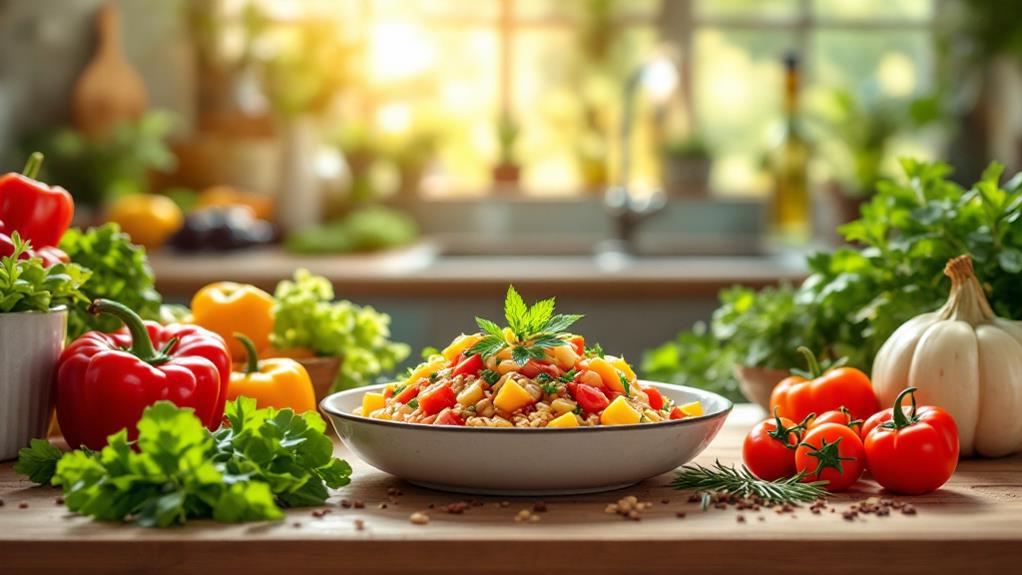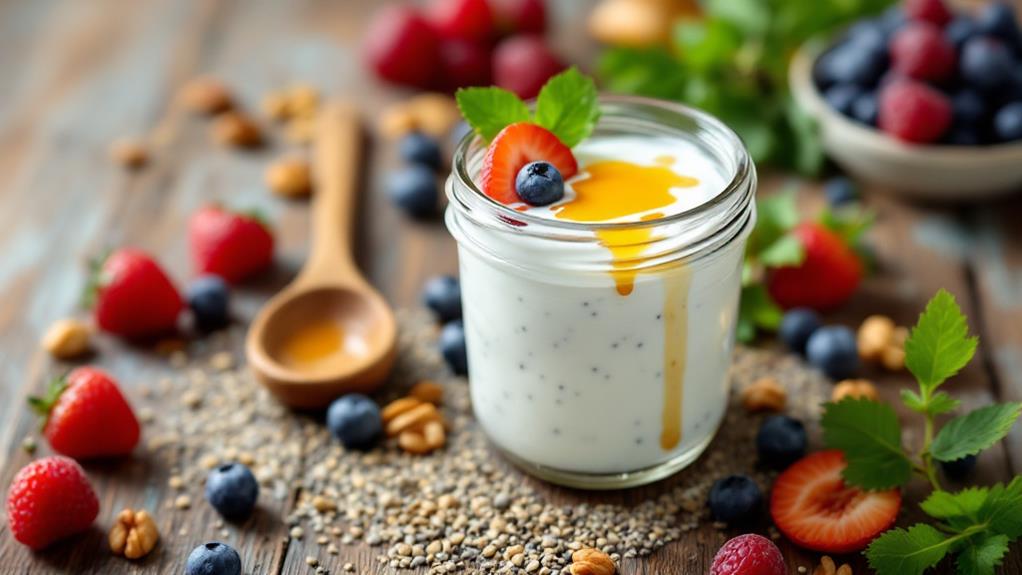20 Exotic Vegetables to Consider Adding to Your Diet
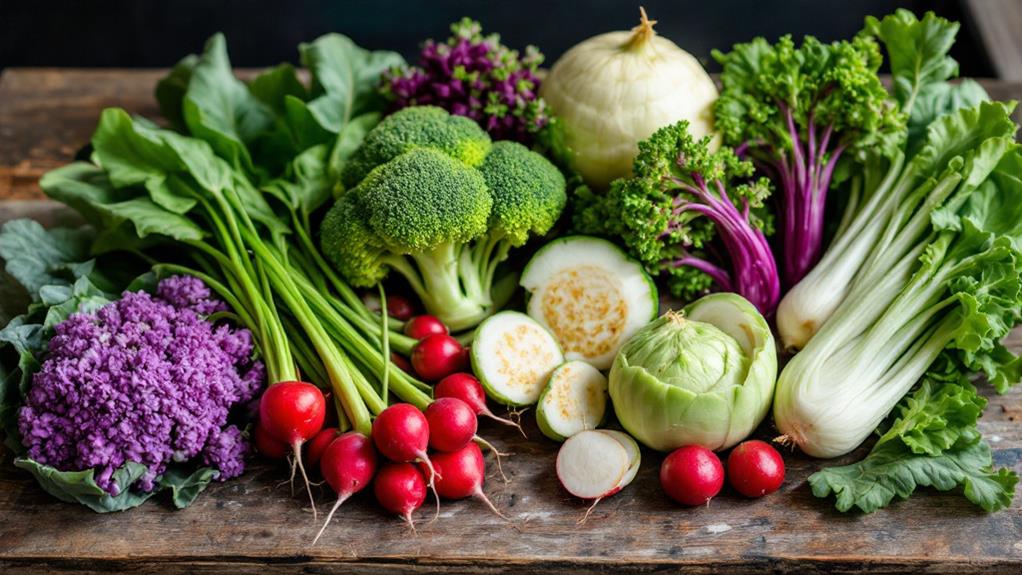
Consider adding exotic vegetables like Daikon, Taro Root, and Jicama to your diet for a nutritional enhancement. Daikon, rich in vitamin C and potassium, can be enjoyed raw or cooked. Taro Root, high in fiber, provides a subtly sweet flavor and supports heart health. Jicama is packed with vitamin C and fiber, perfect for salads or stir-fries. Don't forget Chayote Squash and Delicata Squash, both low in calories and high in vitamins. Bitter Melon and Dandelion Greens offer distinctive flavors with health benefits. Each of these vegetables brings something special to the table, offering more to inspire your kitchen adventures.
Daikon
Daikon offers a delightful crunch and mild peppery flavor that can improve your meals. This winter radish, popular in Asian cuisine, isn't just about taste; it's a nutritional powerhouse. With only 25 calories per cooked cup, daikon provides important vitamins and minerals like vitamin C, copper, potassium, and folate. These nutrients are significant for maintaining your health and energy.
The crunchy texture of daikon makes it a versatile supplement to your diet. You can enjoy it raw in salads, where it adds a rejuvenating bite, or try it pickled for a tangy twist. Cooking daikon in soups or stir-fries also brings out its subtle flavor, complementing other ingredients beautifully. Its fiber content is beneficial for your digestive health, helping to keep things moving smoothly.
Incorporating daikon into your meals isn't just a tasty choice; it may also support your comprehensive well-being. The glucosinolates found in daikon have potential anticancer properties, contributing to a healthier lifestyle. Plus, with its high water content, daikon promotes hydration, which is essential throughout the day. Welcome daikon in your culinary adventures, and enjoy the crunch while reaping the health benefits.
Taro Root
Taro root, a beloved staple in African and Asian cuisines, brings a subtly sweet flavor and soft texture to your plate when cooked. This adaptable root is not just tasty but also a nutritional powerhouse. With only about 142 calories per cooked cup, taro root is a low-calorie option, making it perfect for those looking to maintain or lose weight without sacrificing flavor.
You'll find that taro root is packed with dietary fiber, which is great for promoting digestive health and supporting the growth of beneficial gut bacteria. By incorporating taro root into your meals, you're also enhancing your intake of important vitamins like E and B, which play crucial roles in maintaining good health. Furthermore, taro root is rich in potassium, copper, and folate. These nutrients contribute to heart health, proper brain function, and cell growth.
Jicama
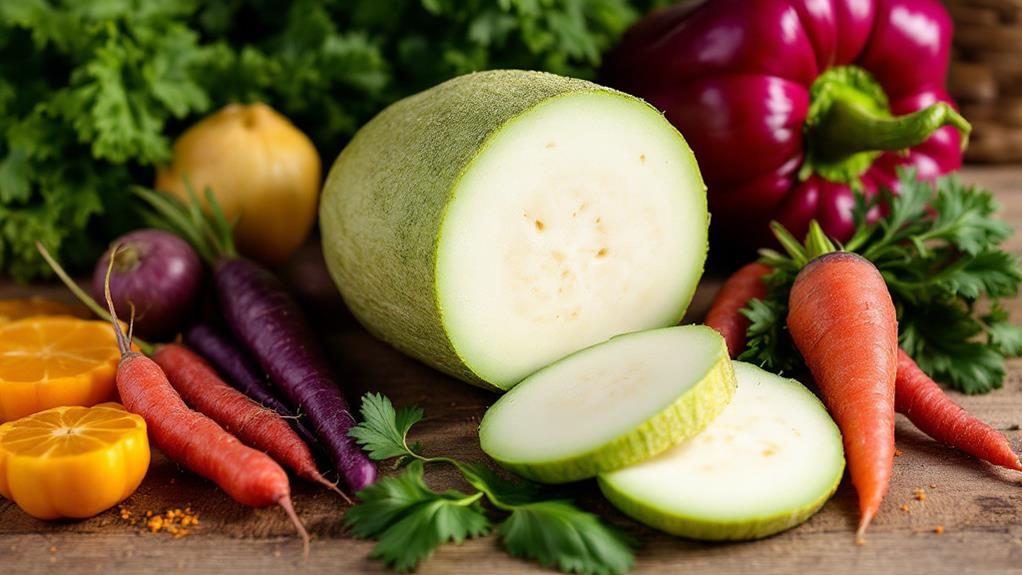
Uncover the invigorating crunch of jicama, an edible root that's a delight for your taste buds and an improvement for your health. With its turnip-like shape and mildly sweet flavor, jicama is a flexible supplement to your diet. Regardless of your pursuit for a low-calorie snack or a nutritious ingredient to elevate your meals, jicama's got you covered. It contains only 38 calories per 100 grams, making it a guilt-free choice for anyone monitoring their caloric intake.
Jicama is packed with vitamin C, offering about 20% of your daily recommended intake per serving. This crucial nutrient supports your immune system, helping you stay healthy and energized. Besides vitamin C, jicama is rich in dietary fiber, including prebiotic inulin. This fiber promotes good gut health and aids digestion, keeping your digestive system running smoothly.
You can enjoy jicama in numerous ways. Slice it raw for a crunchy salad topping or a revitalizing snack. You can also cook it in stir-fries or soups to add a unique texture. By incorporating jicama into your meals, you're not only improving flavor but also enhancing your overall health.
Cassava
Cassava, often known as yuca, is a starchy root vegetable with a resemblance to sweet potatoes and a mild, nutty flavor when cooked. It's an excellent source of vitamin C and B vitamins, along with vital minerals like calcium and magnesium. This makes cassava not just a tasty treat but also a nutritious enhancement to your diet. Considering its benefits, it's worth exploring new recipes that incorporate this versatile root vegetable.
You'll find that cassava is incredibly resilient, thriving even in drought conditions, which is why it serves as a staple food in many developing countries. It provides a significant source of carbohydrates, making it an ideal energy enhancer. But before you plunge into cooking, keep in mind that caution is key. Cassava contains cyanogenic glycosides, compounds that can be toxic if it's not prepared correctly. Always verify it's thoroughly cooked to neutralize these compounds.
There are countless ways to enjoy cassava. You can boil or fry it, or even process it into flour for baking. Each method brings out different aspects of its flavor and texture, inviting you to experiment and find your favorite way to savor this fascinating root vegetable.
Celeriac
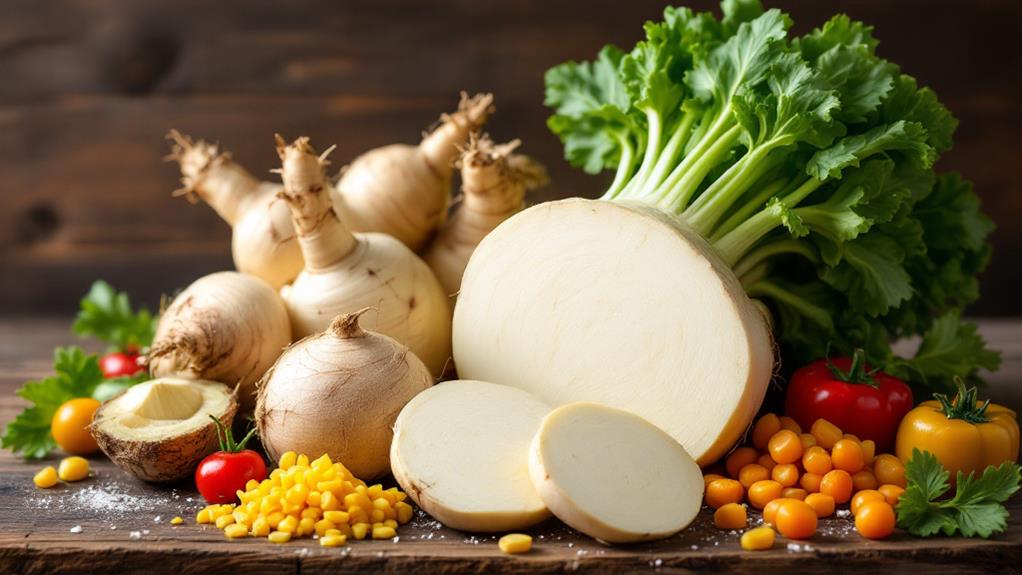
If you're looking for a unique and flavorful improvement to your diet, consider celeriac, also known as celery root. This root vegetable offers a distinctive celery-like flavor and belongs to the same family as celery and parsley. It's a fantastic low-carb alternative to potatoes, making it perfect if you're aiming to cut back on carbohydrates without sacrificing taste or texture.
Celeriac is a nutrient powerhouse, providing a good source of crucial nutrients like phosphorus, potassium, and vitamins C and K. These vitamins are important for maintaining healthy skin, elevating your immune system, and supporting bone health. With only about 42 calories per cooked cup, celeriac is a nutrient-dense option that won't add excessive calories to your meals.
You can enjoy celeriac in a variety of ways, thanks to its versatility. Regardless of whether you prefer it raw in salads or slaws for a revitalizing crunch or cooked in soups, purees, or roasted dishes, celeriac improves both flavor and nutrition. Its adaptability makes it easy to incorporate into different meals, adding depth and a fresh twist to your culinary creations. Give celeriac a try and uncover a new favorite vegetable.
Delicata Squash
After exploring the unique flavors of celeriac, consider incorporating delicata squash into your culinary adventures. This winter squash, with its oblong shape and creamy color, offers a delightful sweet, pumpkin-like flavor that can enhance your dishes. One of its most appealing features is its thin, edible skin, which means less prep work and more enjoyment.
Delicata squash is not only delicious but also nutritious. It's rich in vitamins A and C, crucial for maintaining healthy vision, skin, and immune function. Furthermore, this squash is a good source of calcium, supporting bone health. With only about 18 calories per 100 grams, you can indulge in its flavor without worrying about your calorie intake.
Versatility is another advantage of delicata squash. You can roast it for a caramelized treat, puree it for a creamy soup, or stuff it with your favorite ingredients for a hearty meal. Harvested in late summer to early fall, delicata squash stores well for several months, allowing you to enjoy its benefits throughout the winter. Incorporating delicata squash into your diet is a simple yet effective way to enhance your nutrition and culinary repertoire.
Chayote Squash
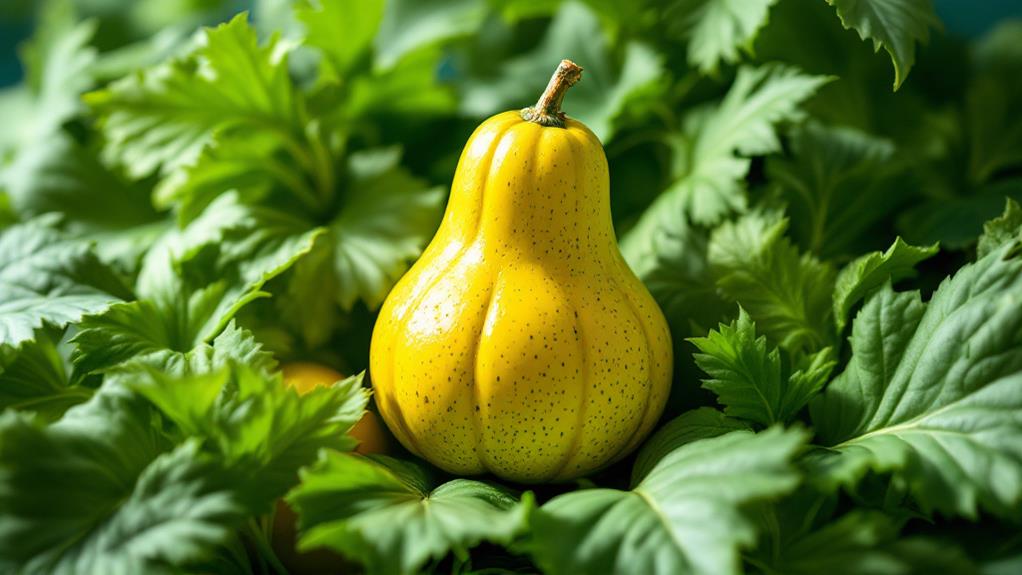
Chayote squash, also known as the vegetable pear, stands out with its bright green, wrinkled skin and mild white flesh, offering versatility in your culinary creations. This exotic vegetable is not only eye-catching but also packed with nutrients that can improve your diet. With just 25 calories per cup, chayote is a low-calorie option perfect for anyone watching their weight. Despite its modest calorie content, it's rich in vital nutrients, providing over 30% of your daily folate needs along with significant amounts of vitamins C and K.
You can enjoy chayote in a variety of preparations, making it a fantastic supplement to your meal repertoire. Try sautéing it with your favorite spices, steaming it as a side dish, or even slicing it raw into salads for a revitalizing crunch. Its mild flavor allows it to blend easily with bold seasonings, offering endless possibilities for creative exploration in the kitchen.
Finding chayote squash is relatively easy, as it's often available in grocery stores and Mexican markets. By incorporating this exotic vegetable into your meals, you not only diversify your diet but also benefit from its nutrient-packed profile.
Sunchokes
Engage yourself in the world of sunchokes, also known as Jerusalem artichokes, and investigate their nutty flavor and nutritional benefits. These edible tubers are not only high in iron, which is vital for red blood cell production, but they're also high in vitamins and other nutrients that support general health. Their rich content of inulin, a prebiotic fiber, promotes digestive health and assists in regulating blood sugar levels. With only about 110 calories per 100 grams, sunchokes are a fantastic choice if you're focusing on weight management.
When it comes to preparing sunchokes, their versatility shines. Consider these preparation methods:
- Roasting: Amplify their nutty flavor by roasting them with olive oil and herbs.
- Boiling: Create a simple side dish by boiling and seasoning with salt and pepper.
- Mashing: Make a unique twist on mashed potatoes by mashing them with garlic and butter.
- Slicing: Add a raw crunch to salads by thinly slicing them.
You can find sunchokes at farmers markets and specialty grocery stores, especially in the fall and winter. So, why not add these nutrient-packed tubers to your culinary repertoire and enjoy their diverse benefits?
Fiddleheads

As you expand your culinary adventures beyond sunchokes, consider incorporating fiddleheads into your diet. These coiled tops of ostrich fern plants are a seasonal delight, especially popular in northern climates during early spring. Fiddleheads provide a unique, earthy flavor that complements many dishes, from stir-fries to pastas and soups. Despite their gourmet appeal, they're surprisingly low in calories, with just about 35 calories per cup, while packing nearly five grams of protein.
Fiddleheads are rich in vitamins and minerals, offering a nutritional enhancement to your meals. They contain abundant vitamins A and C, promoting comprehensive health and well-being. Furthermore, they provide manganese, an important mineral for bone health and metabolism. The presence of carotenoids like lutein and beta carotene in fiddleheads supports eye health, making them a valuable supplement to your diet.
However, it's vital to cook fiddleheads before eating them to prevent foodborne illness. During their short harvesting season, you can find them at farmers' markets or specialty grocery stores. By incorporating fiddleheads into your meals, you're not only diversifying your diet but also reaping the benefits of their rich nutritional profile.
Mashua
For those looking to expand their palate, consider mashua, a flowering plant native to South America renowned for its edible tubers. These tubers boast a pungent, peppery flavor with a hint of nutty undertones, making them a unique enhancement to any dish. They're packed with vitamins and exhibit both antibacterial and anti-inflammatory properties, contributing a nutritious punch to your meals. However, it's crucial to moderate your consumption because excessive intake might affect testicular function.
Mashua's versatility in the kitchen is another reason to try it. You can enjoy it raw in salads or cooked in a variety of dishes. Here are four ways to incorporate mashua into your diet:
- Raw in Salads: Slice thinly and add to salads for a spicy, crunchy texture.
- Roasted or Baked: Roast with olive oil and herbs for a savory side dish.
- Mashed: Mash like potatoes for a unique take on a classic dish.
- Stir-fried: Add to stir-fries for a burst of flavor.
Despite its benefits, mashua isn't widely available in commercial markets. For adventurous eaters, this exotic vegetable offers an exciting opportunity to diversify your diet.
Romanesco
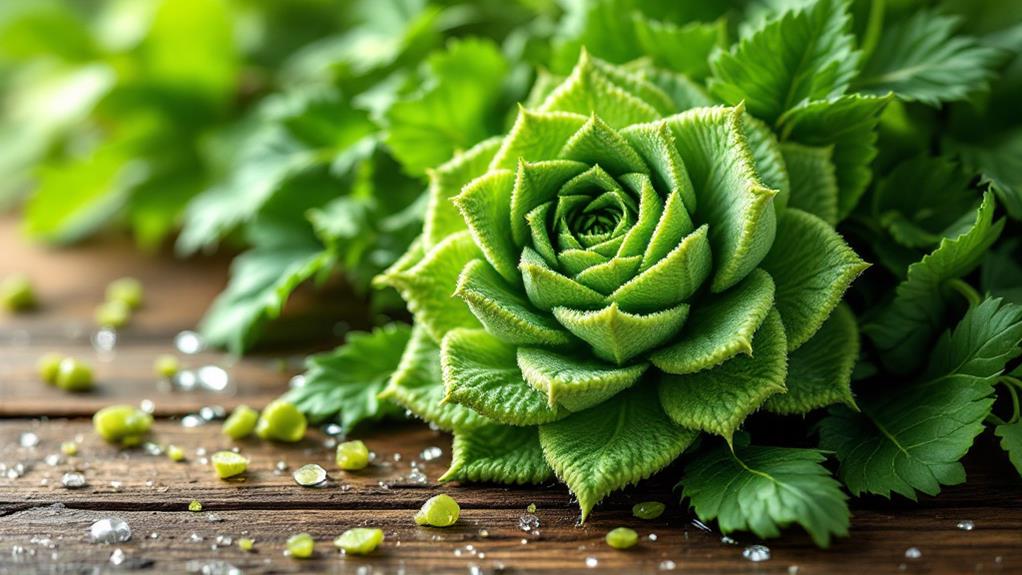
Romanesco, with its strikingly intricate fractal pattern, is an enchanting vegetable that belongs to the brassica family, closely related to broccoli and cauliflower. Its unique spiky flowerets not only make it visually appealing, but also hint at its slightly nutty flavor and crunchy texture. You're in for a treat if you decide to incorporate Romanesco into your meals, as it's rich in vital nutrients like vitamins C and K, dietary fiber, and carotenoids.
This versatile vegetable offers numerous health benefits, including potential anticancer properties, making it a smart addition to a balanced diet. With its low-calorie count, you can enjoy Romanesco guilt-free. Preparing it is simple: try steaming or roasting to preserve its nutrients and amplify its natural flavors. You can also include it in soups and pasta dishes for an extra lift of both taste and nutrition.
When you're ready to delve into culinary creativity, pair Romanesco with ingredients like lemon, garlic, and parmesan cheese. These combinations will raise its taste profile, giving your dishes a delightful twist. So, why not give Romanesco a try and uncover this intriguing cousin of broccoli for yourself?
Bitter Melon
Bitter melon, a gourd with a unique bitter taste, might just be the exotic improvement your diet needs. Known as Momordica charantia, this vegetable is celebrated for its medicinal properties, especially its ability to manage blood sugar levels. If you're dealing with diabetes or simply want to maintain healthy glucose levels, bitter melon could be beneficial. It contains bioactive compounds like charantin and polypeptide-p, which have shown promise in lowering blood glucose and improving insulin sensitivity.
You might wonder how to incorporate this bitter veggie into your meals. Here are a few ideas:
- Stir-Fry: Quickly stir-fry bitter melon with garlic and spices for a flavorful side dish.
- Juice: Blend it with other vegetables and fruits for a nutrient-packed juice.
- Soup: Add to soups for extra nutrition without overwhelming bitterness.
- Stuffed: Hollow out and stuff with a savory filling for a unique dish.
Besides its blood sugar benefits, bitter melon is packed with vitamins C and A, iron, and antioxidants, promoting complete health. So, despite its bitterness, this versatile ingredient can be a powerful supplement to your diet.
Purple Yam
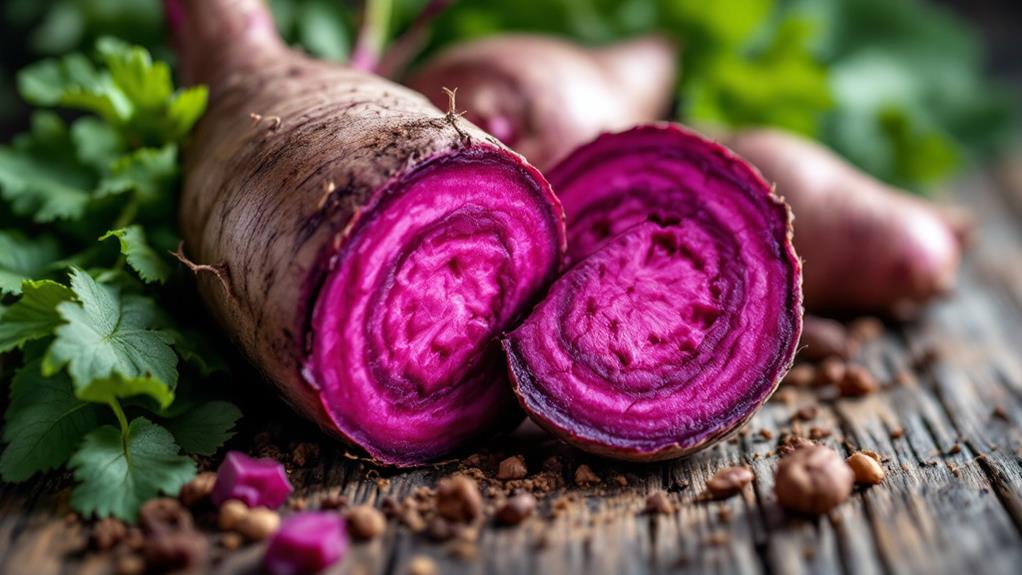
Purple yam, known as ube, is a lively root vegetable that packs both a nutritional punch and visual appeal. Its striking purple color isn't just for show; it comes from anthocyanins, powerful antioxidants that provide numerous health benefits. These compounds are known for their anti-inflammatory properties and can enhance your overall well-being.
Including purple yam in your diet offers a host of advantages. It's rich in fiber, which supports healthy digestion and helps maintain a balanced diet. The fiber content also plays a role in promoting immune function, making it a great supplement to any meal. When cooked, purple yam develops a creamy texture and slightly sweet flavor, making it a versatile ingredient for different recipes.
In many cultures, purple yam is a staple in traditional dishes and desserts. Its unique color and taste can transform ordinary meals into something extraordinary. Regardless of whether you choose to incorporate it into sweet or savory dishes, the purple yam's antioxidants and nutrients make it an excellent choice.
Leeks
After exploring the lively world of purple yams, let's turn our attention to another intriguing vegetable: leeks. These members of the allium family share similarities with onions, yet they boast a milder, sweeter taste that enriches a wide range of dishes. With only about 32 calories per 100 grams, leeks offer a rich flavor without the guilt, making them a healthy enhancement to your meals.
Let's break down the benefits of incorporating leeks into your diet:
- Nutritional Powerhouse: Leeks are packed with vitamins A, C, and K, along with crucial minerals like manganese and iron, supporting your general health.
- Versatile Texture: Regardless of being enjoyed raw in salads or cooked in soups and stews, leeks add a delightful texture to your dishes.
- Pairing Potential: Their flavor pairs wonderfully with ingredients like potatoes, cream, and cheeses, adding depth to numerous culinary traditions.
- Culinary Flexibility: Leeks serve as a flavorful base or garnish, enhancing everything from simple broths to complex casseroles.
When you're looking to enhance your cooking with a vegetable that's both nutritious and flavorful, leeks should definitely be on your shopping list. Their rich flavor and versatility make them a standout choice for any meal.
Dandelion Greens
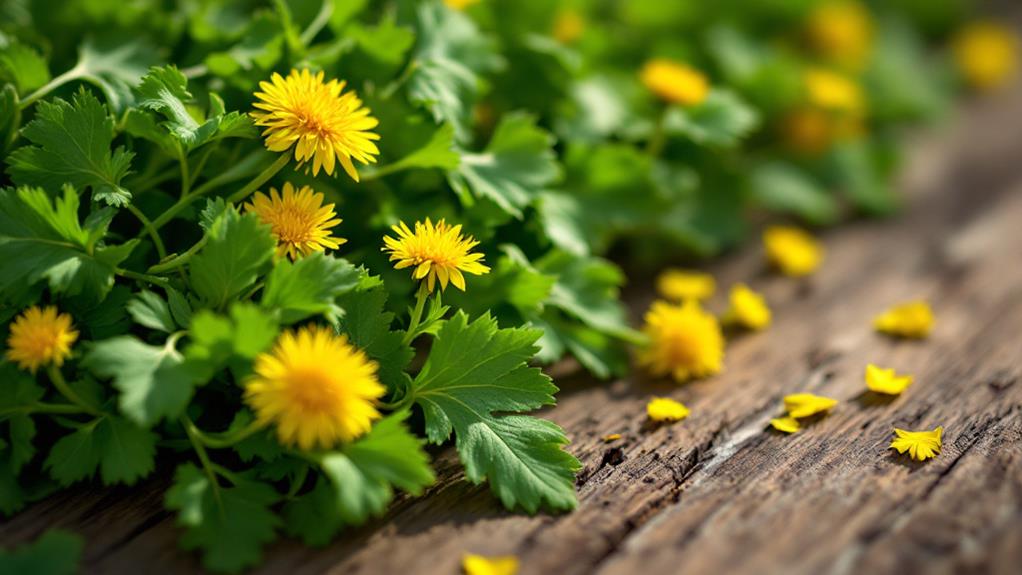
Often overlooked in favor of more conventional greens, dandelion greens are a nutritious powerhouse worth adding to your diet. Packed with vitamins K, A, and C, these greens offer a significant enhancement to your nutritional intake. They're also rich in minerals like iron and calcium, crucial for maintaining strong bones and general health. If you're looking to lose weight or simply eat healthier, dandelion greens are low in calories, making them a smart choice without sacrificing vital nutrients.
You can enjoy dandelion greens in different forms. Their hearty taste, reminiscent of chicory, makes them versatile in the kitchen. Enjoy them raw in salads for a fresh, slightly bitter flavor that pairs well with sweeter dressings. Alternatively, sauté or steam them for a different texture and taste experience. Don't forget, the flowers are edible too, adding a pop of color and nutrition to your meals.
Incorporating dandelion greens into your diet can also support digestion and treat conditions like gout and acne, thanks to their antioxidant properties. Plus, they're rich in prebiotic fibers, which promote healthy gut bacteria, enhancing your general digestive health.
Purslane
Purslane, an edible weed with glossy leaves, offers a unique lemony flavor that can improve your salads and dishes. Despite its low calorie count—just 9 calories per cup—you'll still get a nutrient-packed punch. Purslane is high in potassium and magnesium, crucial for heart health and general wellness. Plus, it's rich in alpha-linolenic acid (ALA), an omega-3 fatty acid that supports cardiovascular health.
When you're planning your meals, consider adding purslane to your repertoire alongside your usual leafy greens or even potatoes for a fresh twist. Its antioxidant properties, including vitamin C and beta carotene, help combat cellular damage and strengthen your immune system, ensuring you stay healthy and lively. Here's why you should consider purslane:
- Versatile Uses: Enjoy it raw in salads, sautéed, or added to soups.
- Nutrient-Rich: Provides key nutrients like potassium, magnesium, and ALA.
- Low-Calorie: Just 9 calories per cup, making it guilt-free.
- Antioxidant Powerhouse: Rich in vitamin C and beta carotene for immune support.
Incorporating purslane into your diet can raise your meals and offer a nutritious alternative to more common vegetables.
Unique Leafy Greens
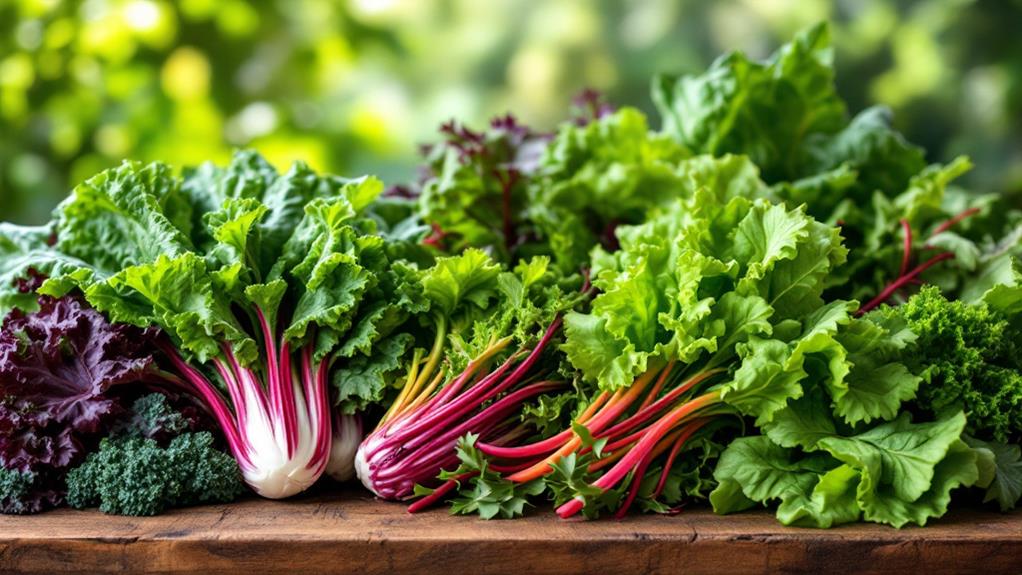
Packed with essential nutrients, unique leafy greens like kale, collard greens, and Swiss chard are fantastic improvements to your diet. They're loaded with important vitamins A, C, and K, which are necessary for maintaining good health and strong immunity. Incorporating these greens into your meals can provide a robust dose of minerals that further support your body's comprehensive well-being.
Consider diversifying your leafy greens repertoire with purslane, a lesser-known edible weed. It offers a glossy texture and a invigorating lemony flavor. Plus, it's incredibly low in calories—just 9 per cup—and rich in antioxidants like vitamin C and beta carotene, making it a powerhouse enhancement to your diet.
Don't overlook dandelion greens, either. Entirely edible, they're abundant in vitamin K and iron. They also have potential benefits for lowering blood sugar and cholesterol levels, making them a smart choice for those mindful of their health.
If you're in the mood for something different, try mizuna, or Japanese mustard greens. With their mildly spicy flavor, they make a nutritious substitute for lettuce, offering high levels of vitamins A and C. Enjoy these greens raw, in smoothies, or cooked—they're versatile and flavorful.
Dulse
Known for its chewy texture and striking red hue, dulse is a seaweed that adds a delightful umami punch to your meals. Found along the coastal regions of Ireland, Scotland, and Wales, this seaweed isn't just about taste; it's a powerhouse of vital nutrients. Rich in iodine, iron, potassium, and vitamins A, C, and B12, dulse makes a valuable supplement to any balanced diet. Plus, it's low in calories and packed with antioxidants, which help protect your body from cellular damage.
You can enjoy dulse in different forms, regardless of it being dried or fresh. Its unique umami taste amplifies the flavor profile of many dishes. Consider incorporating it into:
- Salads: Sprinkle dried dulse for a chewy, flavorful lift.
- Soups: Stir in fresh dulse to deepen the broth's complexity.
- Sandwiches: Use it as a savory element to raise your typical sandwich.
- Snacks: Try dulse chips for a healthy, tasty treat.
Finding dulse is easier than ever, with availability in specialty stores and online. Introducing dulse into your diet is a delicious way to investigate exotic ingredients while increasing your nutrient intake.
Gai Lan
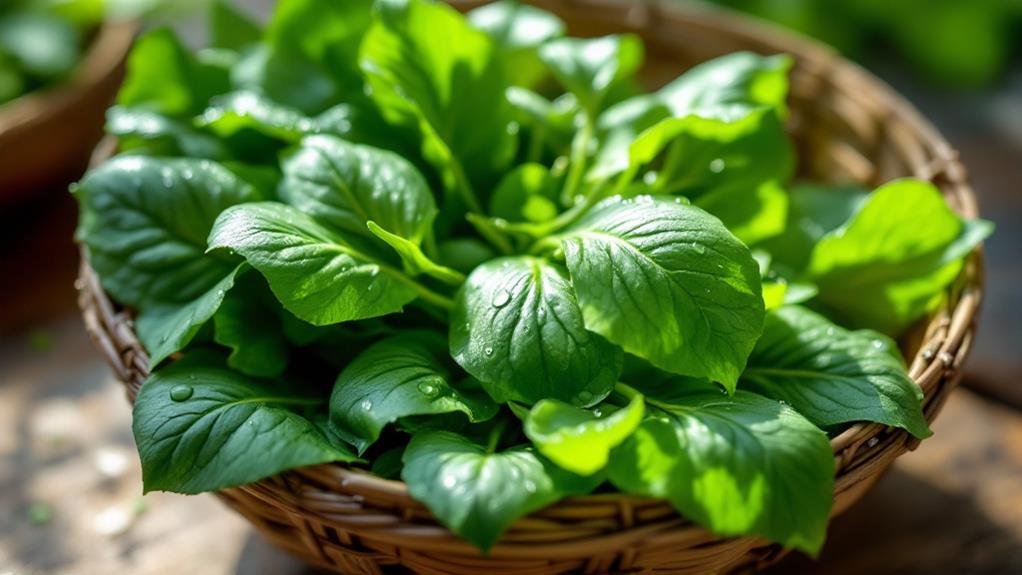
After investigating the wonders of dulse, let's turn our attention to another nutrient-rich gem: Gai Lan. Also known as Chinese kale, this lively member of the broccoli family is characterized by its long green stems and broad dark leaves. Gai Lan is an excellent source of vital vitamins, particularly A, C, and K, making it a powerhouse enhancement to any meal. Just one cup of cooked Gai Lan provides over 100% of your daily vitamin C needs, which is significant for maintaining a strong immune system and healthy skin.
You'll often find Gai Lan at your local farmers market, especially during the summer and fall. This makes it a perfect seasonal treat for those enthusiastic to investigate exotic vegetables. When you buy Gai Lan, you're not only supporting local agriculture but also bringing home a versatile vegetable that can easily uplift your culinary creations. It's commonly used in stir-fry dishes, where it retains its lively color and tender crunch when sautéed or steamed. So, next time you're at the market, consider picking up some Gai Lan. It's a simple way to include a nutritious and flavorful twist to your diet.


